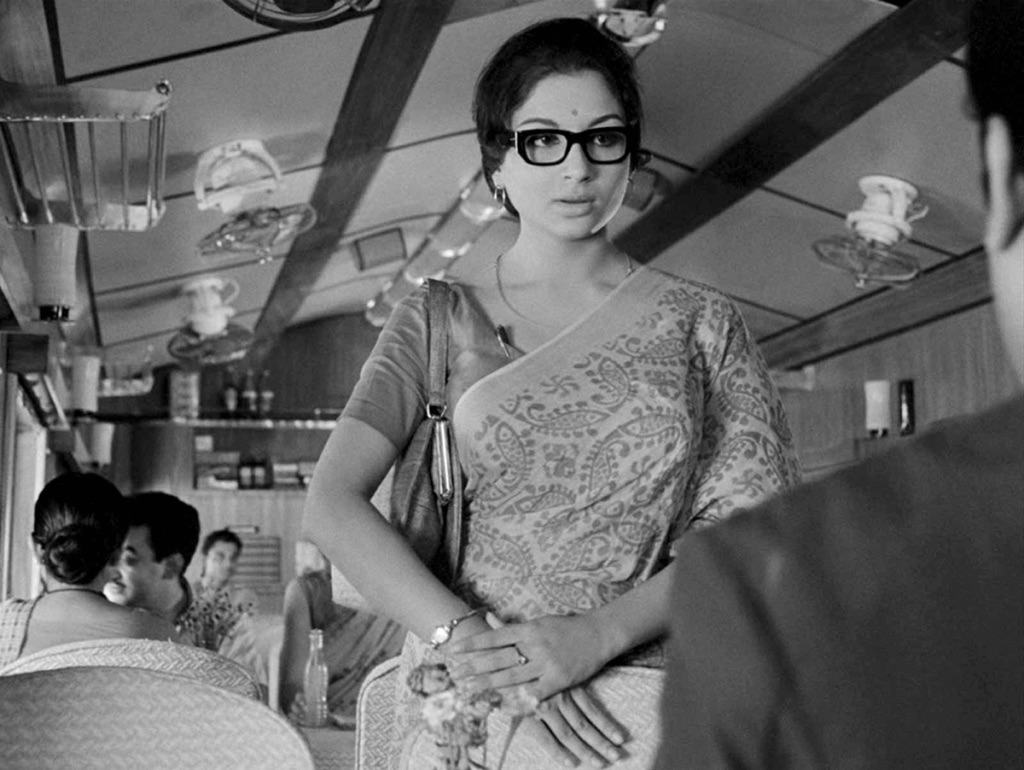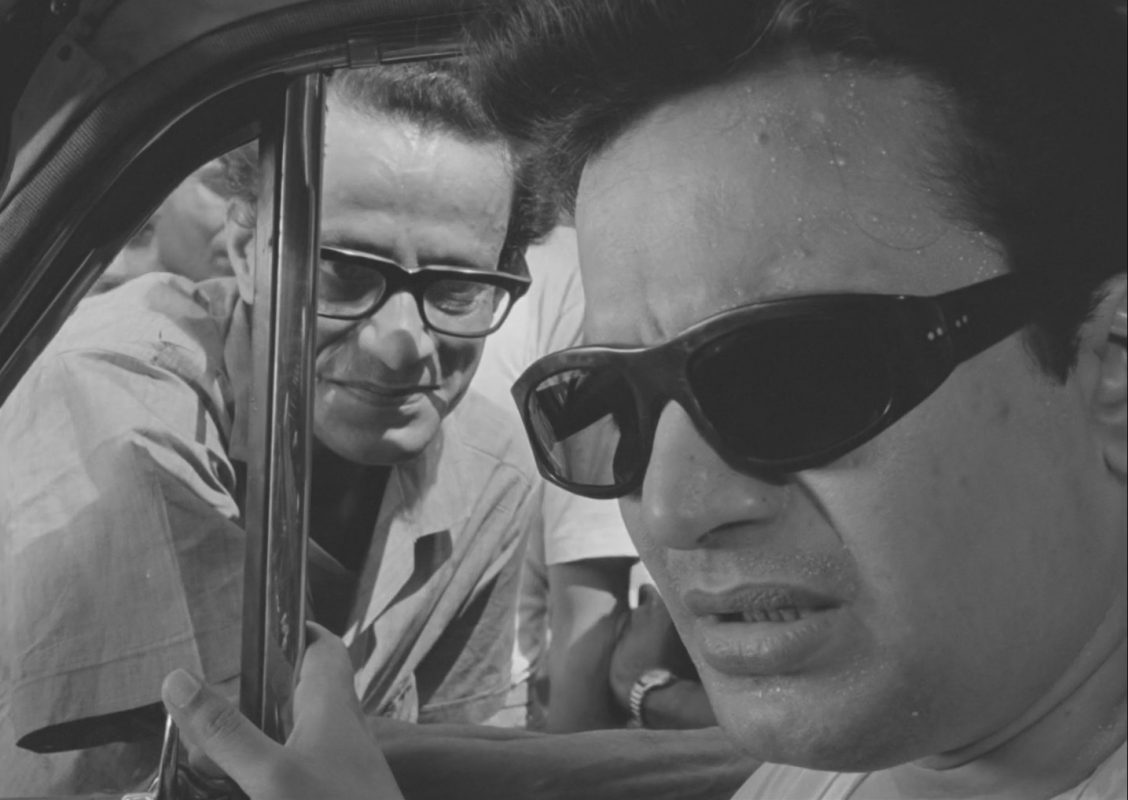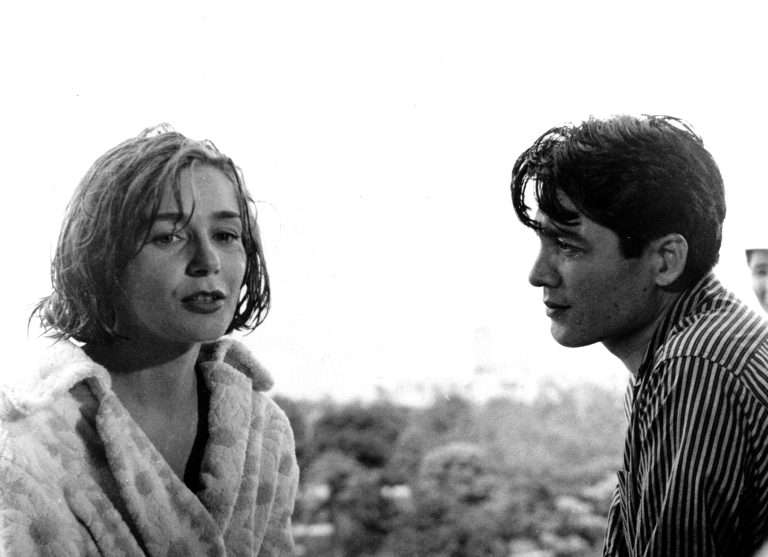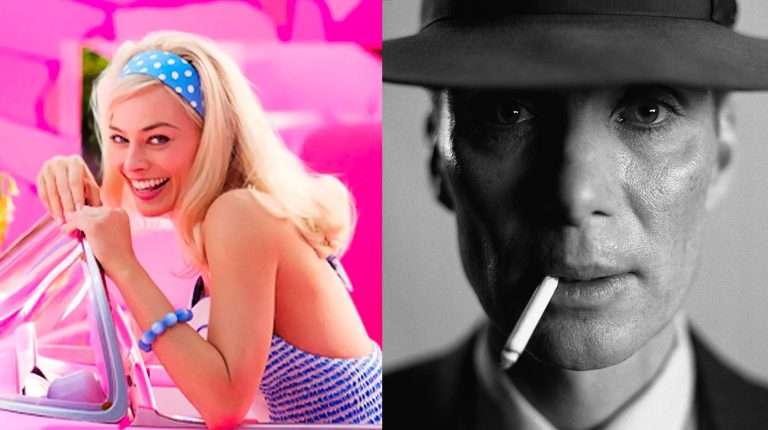In Satyajit Ray’s “Nayak: The Hero” (1966), there is a very important scene set in a flashback. It is an extremely transformative moment of Arindam’s life. He is sitting by the pyre of his mentor and asks his manager, Jyoti, a question with intense apprehension. Arindam is torn between his mentor’s parting advice to him and his own desire to reach for higher success. Jyoti, who is often seen as the voice of reason in Arindam’s life, says that these anxieties about transitioning are displaced as they are in the “age of Freud and Marx.” He implies that there’s no room for traditional notions like rebirth, providence, and implies that Arindam should shed the guilt away from this transition.
Much like the scene described above, this film takes us through many transformative moments of Aridam’s life and paints the portrait of an artist’s state of mind. The film is set on a train journey from Calcutta to Delhi. Arindam is on the way to collect an achievement award and, ironically, goes through an overdue existential crisis during the journey. He moves from coupe to coupe, having conversations with his fellow passengers that represent a spectrum of reactions every artist is subjected to.
Through these conversations, the film touches upon varied themes like the commercialization of art, objectification of an artist, feminism, artistic integrity, etc. However, there is one passenger in the train who opens up the floodgates to Aridam’s subconscious mind. Miss. Sengupta, an independent journalist, picks on Arindam’s mind so she can work on a feature about the artist, beyond everything that has already been. This ruffles a few feathers in Arindam, who opens up to Miss. Sengupta in a way that puts together the puzzle of his juxtaposition.
As a lonely artist in the public eye, he has many layers of thoughts and insecurities that consume his subconscious mind. Released in 1966, this film is contextualized during the peak of Freudian understanding of human psychology. Satyajit Ray, who is known for imbuing global philosophies in Indian cinema, brought out an explorative revelation of the psychological state of an artist. A few recurring Freudian themes in this film being:
1. The tossel of ID, Ego, and Superego
In the film, we see Arindam trying to strike a balance with his triangle of consciousness. He has the ego of a successful man, with the curiosity of an artist and the insecurities that come with having something to lose. Wading through this complex set of emotions, Arindam, ever charming as he is, finds himself disillusioned by unresolved, unaddressed conflicts within his mind. Freud proposes that the human psyche is made up of three components-
- Id, which is the instinct-driven and pleasure-seeking part of the mind. It is primarily focused on gaining immediate gratification.
- Ego: This is a rational mediator. It balances the Id’s impulses with the awareness of social and worldly constraints.
- Superego: This is the conscience representing moral standards, which helps in striving for ideal behavior.
The Ego negotiates between the impulsive Id and the judgmental Superego, often using defense mechanisms to reduce conflict or anxiety. This model by Freud helped shape modern psychotherapy by highlighting unconscious motives, the importance of childhood experiences, and how internal conflicts can affect behavior.
In “Nayak: The Hero,” we observe that Arindam’s psyche is already skewed due to the guilt and shame. He faces pressure from the box office and the industry in general. He has a heavy conscience because he has exploited his position of being in power. At the same time, he is helpless due to his public status, not being able to help out his friend with the union, the lingering fear of becoming a puppet like Shankarda had warned him, and the implied illicit relationship he had with Promila. Taking a look at Arindam’s psyche, his Id drives him towards the temporary pleasures of money and body, his Superego contradicts these instincts on the basis of artistic integrity, morality, empathy, and ultimately, his Ego, falls prey to defense mechanisms like escapism and alcohol.
Also Read: How Satyajit Ray’s ‘Nayak’ Uncovers the Facade Behind Fame
2. The Uncanny
Sigmund Freud’s 1919 essay “The Uncanny” delves into the psychological phenomenon where something familiar becomes unsettling or eerie. He suggests that the uncanny arises due to repression. This repressed material resurfaces in a distorted form, evoking a sense of dread or discomfort. Freud identifies several manifestations of the uncanny, including the fear of inanimate objects coming to life, the experience of doubles or doppelgängers, and the return of repressed memories or desires, representations of death such as ghosts or spirits, and involuntary repetition.
The phenomenon of the Uncanny aids cinematic messaging very effectively as it pushes the boundaries of storytelling into the most immersive medium of all, surrealistic expression. Most recently, a film that similarly contextualised The Uncanny with artistic struggle, impostor syndrome, and fear of mortality was Coralie Fargeat’s “The Substance” (2024). The film delves into the artist’s internal conflict, putting forth how the desire for external validation leads to a never-ending path of a distorted sense of self. The themes of grotesque body horror in the film are a very good example of how an expression of The Uncanny becomes a powerful tool to explore the complexities of identity and morality, all under the weight of societal pressures.
In “Nayak: The Hero,” the perfect representation of the Uncanny is seen in the first dream sequence. Arindam is taking his afternoon nap on the train, twitching as he falls asleep. The sound of the train fades out as heavy winds blow over. We are now inside Arindam’s dream, he is surrounded by huge piles of money, prancing around with almost childlike excitement. Suddenly, the winds stop and telephones ring.
These telephones are being stood up by skeletal hands emerging from under the piles of money, like a warning signal from the dead who have been to the same wasteland as him. A confused Arindam tries to escape when he falls into a pit of money that is sucking him in like quicksand. He reaches out for help to Shankarda, his deceased theater mentor. Appearing out of nowhere, Shankarda seems to be Aridam’s last hope. Dressed in costume and slowly weathering away, Shankarda tries to help Arindam but retracts his hand at the very last minute. The dream ends with him falling into the pit, which transitions into a dark void, often a sensation associated with feelings of insecurity and anxiety.
3. Interpretation of dreams
In “The Interpretation of Dreams,” Freud proposes that dreams serve as a window to the unconscious mind, revealing repressed desires and unresolved conflicts. Through mechanisms like displacement, condensation, and symbolization, the unconscious mind brings up these latent desires in our dreams to prevent distress while being awake. This approach laid the foundation for psychoanalytic therapy, emphasizing the importance of understanding unconscious processes in shaping our behavior and emotional well-being.
Ingmar Bergman’s “Wild Strawberries “(1957) masterfully uses dream sequences to explore the psyche of the protagonist. In this semi-biographical story, Bergman tells the story of Professor Isak Borg, a widowed 78-year-old man who is on a road trip to receive an honorary award. The surreal imagery and symbolism in the film represent Isak’s fear of mortality, guilt, and his unfulfilled aspirations. In the film’s opening dream sequence, Isak wanders in an empty city where clocks are without hands, a faceless figure collapses, and a hearse accident spills out a coffin containing his own body. This vivid dream sequence represents the void of time and inevitability of death, echoing Isak’s repressed anxieties.
In “Nayak: The Hero,” Arindam is also on a journey of conflict. His heart is pushed and pulled with the constantly varying reactions of people to him. He is both smothered and dismissed; objectified and made to feel godlike. His lived experiences are out of his control, and his dreams represent this. In the second dream sequence of the film, Arindam has taken his sleeping pills late in the evening. Two trains cross each other’s paths as we cross the dimensions of reality and enter Arindam’s dreams again.
This time, he is following Promila somewhere unfamiliar, and he hears the screams of the laborers he had once rejected. He goes through a gate in the middle of nowhere, and he sees people from the film industry sitting at a gathering. All of them are wearing dark glasses while looking at him, just like he wears the glasses while he is talking to somebody he doesn’t want to. He continues looking for Promila, who laughs as he is suddenly confronted by Promila’s husband, and the two get into a fight. Manifestations of his repressed guilt and fear of judgment plague his mind as he wakes up, so disturbed by this dream that he feels the need to drink his thoughts away.
Sigmund Freud’s psychoanalytic theory has laid a vast foundation that helps us to delve into the complexities of the human psyche. This has profoundly influenced cinema through the years, a few examples being;
- Hitchcock’s “Spellbound” (1945) reflects Freud’s emphasis on uncovering repressed memories.
- Darren Aronofsky’s “Black Swan” (2010), illustrating The Uncanny.
- Richard Linklater’s “Waking Life” (2001) invites the viewers to have an immersive experience, built around the unconscious motivations and desires that shape our waking lives.
The structure and themes of these films demonstrate how Freud’s psychoanalytic theory has been instrumental in crafting and enriching narratives by exploring the characters’ inner conflicts and desires and offering audiences a window into the complexities of the mind.








